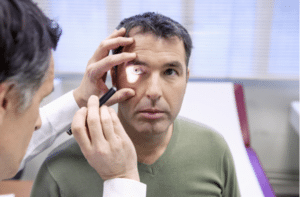
What is a macular hole?
The macula is located in the center of the retina, tissue that lines the back of the eye. A macular hole is a tear in the macula, which forms when the vitreous (the jelly-like substance that fills the middle of the eye) shrinks and starts to pull away from the retina. Oftentimes the vitreous is stuck to the macula, and when the vitreous shrinks it can stretch the macula and tear it.
The vitreous shrinking is, unfortunately, often just a normal part of aging. If it results in a macular hole, your vision may start to blur or seem wavy and you may have sudden difficulty seeing to read, although patients with a macular hole can still have good side (peripheral) vision. Macular holes are typically only found in one eye, and besides being a side effect of aging, they can also be caused by an eye injury or eye disease.
Macular holes may go away on their own, but often they have to be fixed with a surgical procedure. This takes less than an hour and can be done under light sedation. The vitreous is removed, and a gas bubble is placed into the eye to keep the hole in place and allow it to heal. Over time the gas bubble will harmlessly evaporate on its own. You may be asked to stay face down for a few days after the procedure in order to recover successfully.
If you have been noticing problems with your vision, it may be time to contact your eye doctor, to make sure it isn’t a macular hole or something more serious. Call the Eye Care Institute for an appointment today, at the office in Santa Rosa or Petaluma at (707) 546-9800.
